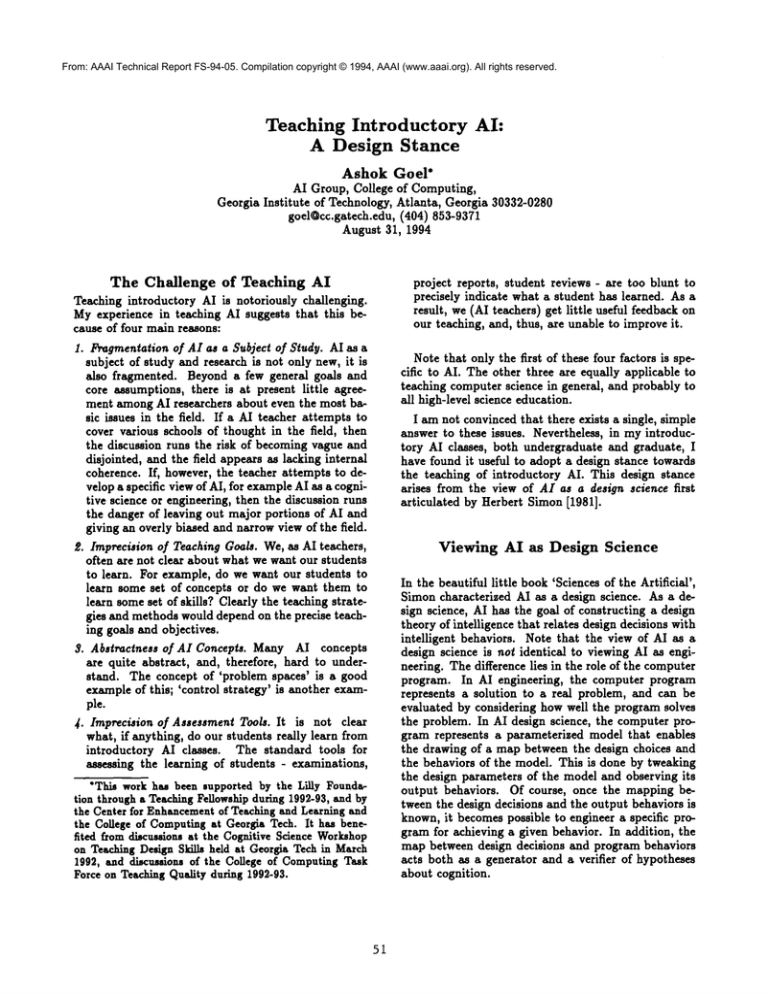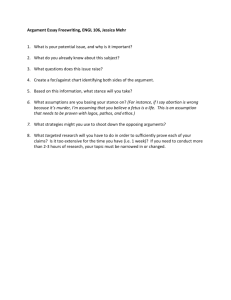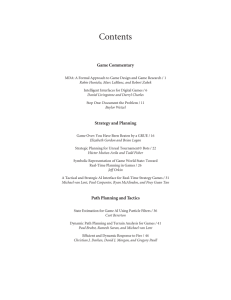
From: AAAI Technical Report FS-94-05. Compilation copyright © 1994, AAAI (www.aaai.org). All rights reserved.
Teaching Introductory
A Design Stance
AIr
Ashok Goel*
AI Group, College of Computing,
Georgia Institute of Technology, Atlanta, Georgia 30332-0280
goelQcc.gatech.edu, (404) 853-9371
August 31, 1994
project reports, student reviews - are too blunt to
precisely indicate what a student has learned. As a
result, we (AI teachers) get little useful feedback
our teaching, and, thus, are unable to improve it.
The Challenge
of Teaching
AI
Teaching introductory AI is notoriously challenging.
Myexperience in teaching AI suggests that this because of four main reasons:
1. Peagmentation of AI as a Subject of Study. AI as a
subject of study and research is not only new, it is
also fragmented. Beyond a few general goals and
core assumptions, there is at present little agreement among AI researchers about even the most basic issues in the field. If a AI teacher attempts to
cover various schools of thought in the field, then
the discussion runs the risk of becoming vague and
disjointed, and the field appears as lacking internal
coherence. If, however, the teacher attempts to develop a specific view of AI, for exampleAI as a cognitive science or engineering, then the discussion runs
the danger of leaving out major portions of AI and
giving an overly biased and narrow view of the field.
#. Imprecision of Teachin9 Goals. We, as AI teachers,
often are not clear about what we want our students
to learn. For example, do we want our students to
learn some set of concepts or do we want them to
learn someset of skills? Clearly the teaching strate&des and methods would depend on the precise teaching goals and objectives.
8. Abstractness of AI Concepts. Many AI concepts
are quite abstract, and, therefore, hard to understand. The concept of ’problem spaces’ is a good
example of this; ’control strategy’ is another example.
~. Imprecision of Auessment Tools. It is not clear
what, if anything, do our students really learn from
introductory AI classes. The standard tools for
assessing the learning of students - examinations,
Note that only the first of these four factors is specific to AI. The other three are equally applicable to
teaching computer science in general, and probably to
all high-level science education.
I am not convinced that there exists a single, simple
answer to these issues. Nevertheless, in my introductory AI classes, both undergraduate and graduate, I
have found it useful to adopt a design stance towards
the teaching of introductory AI. This design stance
arises from the view of AI as a design science first
articulated by Herbert Simon [1981].
Viewing
"This work has been supported by the Lilly Foundation through a TeachingFellowship during 1992-93, and by
the Center for Enhancementof Teaching and Learning and
the College of Computingat Georgia Tech. It has benefited from discussions at the Cognitive Science Workshop
on Tew-hingDesign Skills held at Georgia Tech in Maxch
1992, and discussions of the College of ComputingTask
Force on Teaching Quality during 1992-93.
51
AI as
Design
Science
In the beautiful little book ’Sciences of the Artificial’,
Simon characterized AI as a design science. As a design science, AI has the goal of constructing a design
theory of intelligence that relates design decisions with
intelligent behaviors. Note that the view of AI as a
design science is not identical to viewing AI as engineering. The difference lies in the role of the computer
program. In AI engineering, the computer program
represents a solution to a real problem, and can be
evaluated by considering how well the program solves
the problem. In AI design science, the computer program represents a parameterised model that enables
the drawing of a map between the design choices and
the behaviors of the model. This is done by tweaking
the design parameters of the model and observing its
output behaviors. Of course, once the mapping between the design decisions and the output behaviors is
known,it becomespossible to engineer a specific program for achieving a given behavior. In addition, the
map between design decisions and program behaviors
acts both as a generator and a verifier of hypotheses
about cognition.
Taking a Design
Stance
Towards
Teaching
AI
Howdoes the view of AI as a design science help in
addressing the four issues I raised earlier? In the design
stance I have adopted towards teaching AI, the answers
to the first three issues take the following form:
1. Unification of AI as a Subject o/Study. The view
of AI as a design science suggests the choice between
teaching AI as a cognitive science or as an engineering is a false one. Since AI design science charts the
maps between the internal design decisions and the
output behaviors of intelligent systems, it provides
both a generator and verifier of hypotheses about
cognition, and, in addition, leads to a technology
for designing systems for delivering the specific behaviors needed to solve real problems. In this way,
it rescues the study of AI from being overly biased
and narrow. Further, the theme of design provides a
principled basis for studying AI, and gives it a conceptual coherence that saves it from appearing vague
and disjointed.
~,. Characterization o.f the Teaching Goals. The view
of AI as a design science suggests the developmentof
a set of design skills as the goal of studying AI. By
design skills, I mean here design competences and
abilities, values and strategies.
5. Conteztualization o/AI Concepts. The
design theme provides a context for motivating, explaining, illustrating and operationalizing abstract
AI concepts.
Note that the design stance does not directly provide
an answer to the issue of assessment of learning. I will
return to this issue a little later.
Operationalizing
the
Design
Stance
In general, introductory AI classes involve two main
kinds of activities. Firstly, the teacher delivers a series
of lectures on basic AI facts, concepts, methodsand resuits. Often the lectures explain and illustrate individual concepts and methods through examples but they
either do not relate the various concepts and methods
into a coherent theme or focus on a narrow subset of
concepts as we mentioned earlier. Typically the lectures do not involve the students except as passive listeners. Secondly, the students actively engage in a
series of programming projects. Often the projects
specify both a problem and a partial solution to the
problem (in the form of the algorithm and the data
structures) and ask the students to complete the partial solution, code it in some language, and test the
code on a given set of data. Typically students work
on the projects individually, and the various projects
are unrelated to one another and only marginally related to the concepts and methods discussed in the
class. From the perspective of learning design skills,
the value of these two kinds of activities is quite limited.
The goal of learning design skills, instead, suggests
teaching strategies that emphasize design related activities such open-ended design projects, design case
studies, construction and evaluation of reed designs,
exploration and experimentation, articulation and reflection, communication and collaboration, etc [Goel
1993].
Design Case Studies: In the beginning of the
course, I trace in somedetail the evolution of the design
of an AI system. In my undergraduate introductory
AI class, I often use the Router system as a case study,
where Router is an experimental multistrategy planning and learning system for robot navigation developed by my research group [Goel et al 1992, 1993]. The
goal is to illustrate AI in action and groundit in realistic problems. I use Router as a case study to illustrate
some of the many kinds of problems that AI seeks to
address (e.g., planning and learning in the real world),
the kinds of issues that arise in these problems (e.g.,
competence and performance; representation,
organization, use and acquisition of knowledge, strategic control), the kinds of solutions that AI develops (e.g., multistrategy reasoning, plan reuse, performance-driven
and experience-based learning). I also use this case
study to illustrate
the kinds of mistakes we made in
designing Router, methods for evaluating AI systems
such as Router, and what and how we learned from the
evaluation.
Design Projects: Then, I give the students a sequence of interrelated design projects in which each
design project builds on preceding ones. The goal is to
illustrate the competence and performance differences
made by AI concepts and methods. In one undergraduate introductory AI class, in the first project (which
also introduced Lisp) the students designed and developed a system that used (a limited form of) depth-first
search on a qualitative spatial model of the Georgia
Tech campus to form navigation plans. In the second
project, they used (a form of) mean-ends analysis
a hierarchically-organized spatial model for the same
task of navigation planning. In the third project, they
stored the solutions generated by means-ends analysis
in a case memory, and formed new navigation plans
by retrieving and modifying old cases. The system the
students built in the fourth project dynamically and
opportunistically selected and instantiated a specific
planning strategy at planning time. It also interpreted
feedback on the execution of a plan and used the feedback to update the world model; and so on. In this
way, through the various design projects, each student
designed and developed his/her micro-Router system.
Note that the different projects used different methods
for the same problem. Note that the complexity of the
design increased in the latter projects.
Exploration
and Experimentation:
I make each
design project somewhat open-ended. The goal is to
provide students with opportunities for active learning
through exploration and experimentation. Instead of
fully specifying the problem, I deliberately leave the
problem specification
somewhat incomplete and ambiguous so that it is open to multiple interpretations.
Similarly, I deliberately leave the specification of the
AI methods in the project incomplete and ambiguous.
I ask the students to explore different problem interpretations and experiment with different AI methods
both with in and across families of methods. This exposes the students to use AI concepts and methods for
analyzing problems in addition to constructing solutions.
Evaluation and Reflection: I ask the students to
evaluate their systems in a number of dimensions including efficiency of processing and scalability, quality of solutions and flexibility, knowledgerequirements
and generality. In addition, I ask them to empirically
compare the performance of alternative designs (that
instantiate alternative AI methods) along these dimensions. Then, I ask them to use this evaluation as a basis
to reflect on the design process, and to critique the AI
concepts and methods they used in their designs.
In general, students work on these projects in rotating teams of two or three. This enables the students
to appreciate different perspectives on a problem, to
articulate their own views, and to learn from one another. In the classroom, I use design in general as the
context for motivating, introducing, illustrating and
explaining basic AI concepts and methods. Outside
the class, the Teaching Assistants and I work with the
students in articulating design choices, observing the
output behaviors of their systems, and analyzing the
relationship between the design choices and the output
behaviors.
Outcomes of the Design
Stance
Myanalysis of the outcomes of these teaching goals and
strategies are based on four main sources of information: the performance of students on the examinations
and the design projects, the quality of class and individual discussions, student evaluation of their learning
and my teaching, and, in one particular case, interviews with the students conducted by Georgia Tech’s
Center for Enhancement of Teaching and Learning.
The main results are that students were better motivated, they better understood the significance of many
AI concepts and methods and the connection between
them, they enjoyed the design projects a lot, and they
developed better design skills. However, the above
teaching strategies seemedto have little or no impact
on their learning of Lisp, and their experiments with
53
the design projects did not enable them to critique AI
concepts and methods probably because of insufficient
scaffolding.
Tools for Assessment
of Teaching
Clearly, the assessment of teaching and learning are
critical issues in improving the quality of teaching and
learning. Assessment of a student’s learning enables
the teacher to provide feedback which can help reformulate the student’s learning goals and strategies.
Similarly, the assessment of teaching can provide feedback to the teacher which may lead to a reformulation
of the teaching goals and strategies.
The above analysis of the outcomes of my teaching
strategy and methods is based on the standard methods and tools for assessing teaching and learning such
as the performance of students on examinations and
projects, and student evaluation of teaching, But these
assessment tools are informal and imprecise at best.
Thus, my analysis of the outcomes too is informal and
imprecise.
Given that we want to enhance the quality of AI
teaching, we need to develop methods and tools for
assessing the teaching so that we can determine what
worked, what did not and why, how can we improve the
teaching, and for sharing this knowledgewith other AI
educators. The design stance towards teaching AI does
not seem provide any help in this regard.
Recently, I have begun to use ’course portfolios’ patterned after [Cerbin 1993] for self-assessment of teaching. A course portfolio apparently provides three main
benefits. First, it forces the teacher to explicitly and
precisely spell out the teaching goals and objectives,
the teaching strategies
and methods, and how the
strategies are expected to accomplish the goals. While
all teachers start with some goals and strategies, often they are implicit and tacit, and the relation between them is imprecise and ambiguous. Second, the
course portfolio ties the assessment of teaching with
the assessment of learning. If the teaching goals and
strategies are clear and the relation between them is
precise, and if the students’ learning can be assessed
to some degree, then the assessment of the students’
learning also provides a partial assessment of the teaching. Third, the course portfolio is a written document,
constantly evolving, and sharable with other educators.
Since I started developing and using course portfolios
only recently, it is still too early to makeany conclusions about the impact of a teaching strategy based on
the portfolios. Nevertheless, my preliminary impression from the course portfolio I have developed for one
introductory AI class [Goel 1994] appears to confirm
the advantages of the design stance towards teaching
AI.
References
Bill Cerbin. The Course Portfolio as a Tool for Continuous Improvement of Teaching and Learning. Paper
presented at the American Association for Higher Education Double Feature Conference: The 8th Annual
Assessment Conference and The 1st Continuous Quality Improvement Conference, Chicago, June 1993.
Ashok Goel and Todd Callantine.
An ExperienceBased Approach to Navigational
Path Planning.
In Prec. IEEE/RSJ International
Conference on
Robotics and Systems, Rayleigh, North Carolina, July
1992, IEEE Press, VolumeII, pp. 705-710.
Ashok Goel, Michael Donnellan, Nancy Vasquez, and
Todd Callantine. An Integrated Experience-Based Approach to Navigational Path Planning for Automonous
Mobile Robotics. In Proc. IEEE International Conference on Robotics and Automation, Atlanta, Georgia,
May 1993, pp. 818-825
Ashok Goel. Lilly Project Report: Teaching Design
Skills. Internal Memo,AI Group, College of Computing, Georgia Institute of Technology, October 1993.
Ashok Goel. A Course Portfolio for CS 6361, Graduate
Introduction to Artificial Intelligence. Internal Memo,
AI Group, College of Computing, Georgia Institute of
Technology, February 1994.
Herbert Simon. The Sciences of the Artificial.
Edition. Cambridge, MA:MIT Press, 1981.
Second
Working Notes of the Cognitive Science Workshop on
Teaching Design Skills, Georgia Institute of Technology, Atlanta, March 1992.
54




